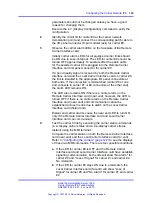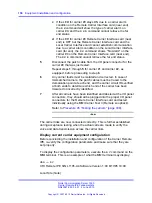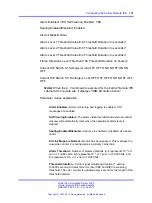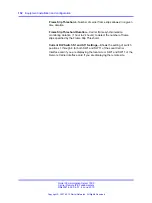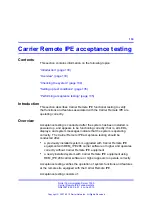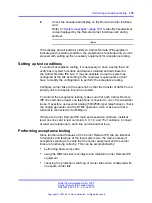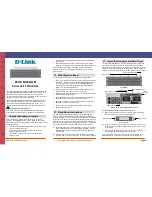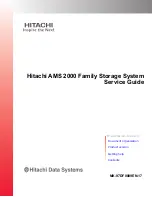
120
Equipment installation and configuration
Configuring the remote MMI terminal port
The MMI port can be configured in the SDI or the MMI mode. When the
MMI terminal is in the SDI mode, you can perform system administration
tasks from the local or the remote site. When the MMI terminal is in the
MMI mode you can:
•
perform carrier functions such as display status, logs, performance
information, history, and messages
•
enable or disable alarms
•
clear errors and logs
•
set performance parameters
•
specify tests
MMI mode
In the MMI mode, a terminal or TTY is connected to the local MMI port at
the Local Carrier Interface card and another terminal or TTY is connected
to the MMI port at the Carrier Remote IPE as described in Installing SDI
and TTY cables in this chapter. Each terminal controls the local MMI
functions of the card it is connected to and some display functions at the
distant site.
The default MMI interface characteristics are set in the Local and Remote
Carrier Interface card EEPROM as follows:
•
Speed: 2400 bps (speed is an exception, it is selected using DIP SW1
position 1 where OFF = 2400 bps and ON = 1200 bps)
•
Character width: 7
•
Parity bit: mark
•
Stop bit: 1
The MMI mode is accessed from the initial (INIT) mode by entering
L
on
the MMI terminal or TTY to log in. For multiple Local Carrier Interface
cards connected in a daisy-chain, to log in to the specified Local Carrier
Interface card, enter
L <sl>
, where
sl
is the address and the superloop
number of the specified superloop, as shown in and .
Password is
M1LINK
The MMI command line prompt in the initial mode is: CRI>, but after
logging in, the prompt changes to: CRI::>
The prompt in a Maint/SDI daisy-chain configuration is CRI: nnn>, where
nnn is the address of the LCI in the chain.
Nortel Communication Server 1000
Carrier Remote IPE Fundamentals
NN43021-555 04.01
4 June 2010
Copyright © 2007-2010 Nortel Networks. All Rights Reserved.
.
Содержание Communication Server 100
Страница 213: ......
























